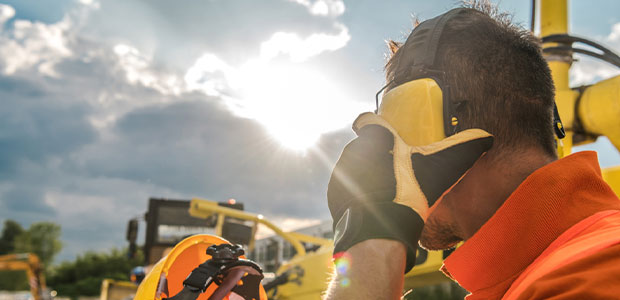
Workplace Noise: The Stealth, Long-Term Hazard
Construction workers encounter multiple hazards on the job, but, more often than not, noise is not considered as critical as some of the other present dangers.
- By Zachary Richman
- Oct 01, 2021
There is no question that construction sites are loud. Between the bulldozers rumbling across the ground, jackhammers breaking through concrete or saws cutting through metals and woods, noise is almost impossible to avoid. According to the National Institute for Occupational Safety and Health (NIOSH), the construction industry has the second highest risk for developing hearing loss from noise exposure of any industry. NIOSH also reports that 23 percent of workers in the U.S. experience hearing difficulty after being exposed to noise on the job. Another 15 percent have experienced tinnitus, the sensation of ringing or buzzing in one or both ears.
Construction workers encounter multiple hazards on the job, but, more often than not, noise is not considered as critical as some of the other present dangers. Hearing loss is typically gradual and not immediately noticeable, unlike other potential workplace injuries such as cuts, head wounds and broken bones. Hearing damage is preventable but cannot be undone. There is no surgery or cure for noise-induced hearing loss. Repeated exposure to high noise levels, such as working near machinery or operating heavy equipment, can lead to permeant hearing loss or tinnitus. Ask any construction worker who now has difficulty hearing what they should have done differently, and the majority will agree they should have worn hearing protection before the damage was done.
How Loud is Too Loud?
The loudness of sound is measured in units called decibels (dB). The decibel is measured on a logarithmic scale. This means that a small change in the number of decibels results in a large change in the amount of noise and the potential damage to a person’s hearing.
The higher the decibel level, the louder the noise is and the shorter the amount of time it takes for hearing loss to occur. A casual conversation between two individuals can generate between 50-60 dB of sound while a jet engine taking off can measure around 140 dB. The average construction site has a decibel level between 80-90 dB, but many common tasks found on the jobsite can be well above that. For example, a forklift produces about 93 dB and a jackhammer more than 100 dB. The CDC estimates that levels above 70 dB over a prolonged period may start to damage hearing and levels above 120 dB could cause immediate harm.
The decibel level, the distance between a person and the source of the noise, and the amount of time they are exposed can all result in a risk for hearing loss. OSHA has set a legal limit on the amount of noise someone can be exposed to in the workplace. These limits are calculated based on a worker’s time-weighted average throughout an eight-hour day. OSHA’s permissible exposure limit (PEL) is 90 dB for all workers for an eight-hour day. The OSHA standard uses a 5 dB exchange rate, meaning if the decibel level is increased by 5 dB, the amount of time a person can be exposed to that level is reduced by 50 percent. For example, a construction worker can be exposed to 90 dB of noise for eight hours but 95 dB for only four hours.
This article originally appeared in the October 2021 issue of Occupational Health & Safety.